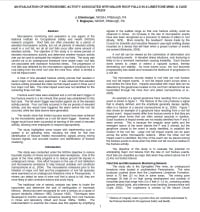Mining Publication: An Evaluation of Microseismic Activity Associated with Major Roof Falls in a Limestone Mine: a Case Study
Original creation date: February 2007
Authors: JL Ellenberger, TS Bajpayee
NIOSHTIC2 Number: 20031651
2007 SME Annual Meeting and Exhibit, February 25-28, Denver, Colorado, preprint 07-103. Littleton, CO: Society for Mining, Metallurgy, and Exploration, Inc., 2007 Feb; :1-5
Microseismic monitoring and evaluation is one aspect of the National Institute for Occupational Safety and Health (NIOSH) research program. Roof falls are often preceded by a period of elevated microseismic activity, but not all periods of elevated activity result in a roof fall, nor do all roof falls occur after some amount of elevated activity. The objective of this study is to review periods of elevated microseismic activity and determine whether fracture activity rate can be used to anticipate the initiation of roof falls. The study was carried out at an underground limestone mine where major roof falls are associated with excessive horizontal stress. The progression of roof falls was detected by the microseismic signature produced by the rock falling from the mine roof onto the mine floor, which is termed a roof fall impact event. A total of nine elevated fracture activity periods that resulted in seven major roof falls were examined. It was observed that elevated fracture activity preceded the initial roof fall impact event in three out of four major roof falls. The initial impact event was not identified for the remaining three roof falls. Fracture event rates were analyzed and a roof fall alarm trigger of five fracture events in a ten minute time period was established for this test case. The fall alarm trigger was tested against six of the elevated activity periods. Four roof falls occurred in the six periods of elevated activity, and two would have triggered the alarm before the roof fall occurred, while two false alarms were generated. The results show that limited success would have been achieved by the microseismic system as a roof fall alarm trigger. However, the trigger would have been successful at warning of the onset of elevated activity, allowing mine employees to respond appropriately. The study highlighted some issues with implementing such a system in an operating mine, including the need for real time identification of fracture related microseismic signals among mining induced signals, and accurate location and identification of fracture clustering.

NIOSHTIC2 Number: 20031651
2007 SME Annual Meeting and Exhibit, February 25-28, Denver, Colorado, preprint 07-103. Littleton, CO: Society for Mining, Metallurgy, and Exploration, Inc., 2007 Feb; :1-5
- Analysis of Pillar Design Practices and Techniques for U.S. Limestone Mines
- Assessing Roof Fall Hazards for Underground Stone Mines: A Proposed Methodology
- Characteristics of Mining-Induced Seismicity Associated with Roof Falls and Roof Caving Events
- Detecting Strata Fracturing and Roof Failures from a Borehole Based Microseismic System
- Field Observations and Numerical Studies of Horizontal Stress Effects on Roof Stability in U.S. Limestone Mines
- Mapping Hazards with Microseismic Technology to Anticipate Roof Falls - A Case Study
- Preventing Injuries Caused by Unrecognized Stone Mine Roof Beam Failures With a Pro-Active Roof Control Plan
- The Relationship of Roof Movement and Strata-Induced Microseismic Emissions to Roof Falls
- Roof and Rib Hazard Assessment for Underground Stone Mines
- Technique to Assess Hazards in Underground Stone Mines: the Roof Fall Risk Index (RFRI)